These photos from the Isle of Capri and Pompeii need no descriptions!
Category: Umbra Blog
This blog documents the experiences of students currently studying at the Umbra Institute in Perugia, Italy, offering an account of their day-to-day experiences, extra- and co-curricular activities, and special events. We hope you gain some insight into what adventures Umbra students find outside the classroom during their semester in Perugia, a medieval town in the mountains of Umbria. Cheers!
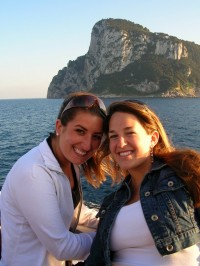 Aqua-blue glistening water, tangy yellow lemons, spectacular, breath-taking views, world-class food with world-class hospitality all smothered under the warm, soothing southern Italian sun.
Aqua-blue glistening water, tangy yellow lemons, spectacular, breath-taking views, world-class food with world-class hospitality all smothered under the warm, soothing southern Italian sun.
That’s just some of what Umbra students experienced for three glorious days while on the Umbra optional weekend trip to Naples, Pompeii, Sorrento and Capri. While soaking up the warm Italian rays students toured the ancient, unearthed city of Pompeii, experienced some of Naples’ rich history (and tasty pizza) as well as hiked through the windy and daring paths of the isle 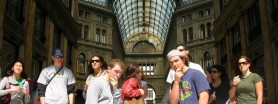 of Capri.
of Capri.
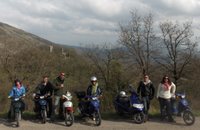 A group of students discovered their new favorite mode of transportation to explore the region of Umbria – rented scooters. Anywhere from six to ten friends spent the weekend behind the wheel as they toured their way to Gubbio. Gubbio is located in northeast Umbria, where the roads curve and swerve up and down through picturesque hills. With its postcard-quality Italian countryside views, Gubbio is arguably one of Italy’s finest cities.
A group of students discovered their new favorite mode of transportation to explore the region of Umbria – rented scooters. Anywhere from six to ten friends spent the weekend behind the wheel as they toured their way to Gubbio. Gubbio is located in northeast Umbria, where the roads curve and swerve up and down through picturesque hills. With its postcard-quality Italian countryside views, Gubbio is arguably one of Italy’s finest cities.
On their scooters, the group – comprised mostly of full-year students – were able to follow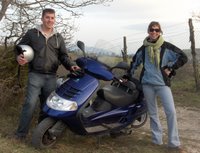 country roads to visit smaller Italian cities that are bypassed by bus and train routes that bring both locals and tourists throughout Italy. With a group that got as big as ten, they created quite the scene for motorists and locals they passed in a long strand of highly-revved scooters. If the weather cooperates, the students plan to hit the open road again this weekend to explore more of Umbria.
country roads to visit smaller Italian cities that are bypassed by bus and train routes that bring both locals and tourists throughout Italy. With a group that got as big as ten, they created quite the scene for motorists and locals they passed in a long strand of highly-revved scooters. If the weather cooperates, the students plan to hit the open road again this weekend to explore more of Umbria.
(Text and photos by Reid Williamson, Student Services Intern)
 Students organized and held a cooking contest for the eight student apartments within the Monteluce Residence. Awards were provided to students for the best dish, the best overall culinary contributions, and the most creative dish. Jesse Gamar and Bryan Yuhas won the award for best overall creations, including their eggplant, ricotta, and chicken wraps. These wraps, along with Kelly Ferro’s and Rebecca Pilgrim’s version of Bananas Foster, tied for best dish. Ryan Huseby’s Roman-Era Olive Relish was voted as most creative dish. The men from Apartment Six – Dino Campellone, Amico DiFranco, and Paul LaGuardia – received the honorable mention award for their pasta dish.
Students organized and held a cooking contest for the eight student apartments within the Monteluce Residence. Awards were provided to students for the best dish, the best overall culinary contributions, and the most creative dish. Jesse Gamar and Bryan Yuhas won the award for best overall creations, including their eggplant, ricotta, and chicken wraps. These wraps, along with Kelly Ferro’s and Rebecca Pilgrim’s version of Bananas Foster, tied for best dish. Ryan Huseby’s Roman-Era Olive Relish was voted as most creative dish. The men from Apartment Six – Dino Campellone, Amico DiFranco, and Paul LaGuardia – received the honorable mention award for their pasta dish.
This was the first cooking contest organized in the Monteluce Residence. The idea came from former student and current Umbra intern, Reid Williamson, who lived in Monteluce in the fall semester. The Monteluce Residence is a unique student housing option in a residential area of Perugia.
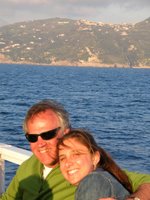 It’s not uncommon to see Umbra students walking the streets of Perugia with their families. But several staff members were surprised to run into Meghan Shellenberg and her father, Paul, on the ferry from the Isle of Capri (in photo) this weekend. Staff and students were visiting Capri, Naples, Sorrento, and Pompei for an optional weekend excursion.
It’s not uncommon to see Umbra students walking the streets of Perugia with their families. But several staff members were surprised to run into Meghan Shellenberg and her father, Paul, on the ferry from the Isle of Capri (in photo) this weekend. Staff and students were visiting Capri, Naples, Sorrento, and Pompei for an optional weekend excursion.
For many students, these visits allow them the opportunity to play tour guide and to impress their parents with their familiarity of the language and local culture. In return, the students usually get spoiled to nice meals and some shopping!
Congratulations to Nicole Magpayo, winner of the March Photo of the Month Contest. Magpayo’s photo, “Sunset in Oia,” was taken while she was on Spring Break in Greece.
Magpayo was not the only one who left Perugia for warmer climates on Spring Break. Many students headed to cities all over Spain, while others headed to the beaches of southern Italy and Greece.
With less than one month remaining in the program, students’ focus now turns to finishing their academic work while finding time to enjoy the warm weather which has arrived in Perugia.
In photos: Nicole Magpayo’s winning photo for the March contest; “Rowboat at Sunset,” a photo taken by Casey Coe in Sicily; and “Carriage Ride,” a photo of Kyndra Myers, Carissa Roselli, Courtney Lee, and Melinda Stiles, taken by Stiles in Sevilla, Spain.
From inside the windows of an historic palazzo in the center of Perugia, one can see the Church of San Domenico towering above other buildings in the distance. Umbra students learned yesterday that the stained glass windows which adorn the church were made from inside the buildin g they were touring – the Studio Moretti Caselli.
g they were touring – the Studio Moretti Caselli.
The studio has been producing stained glass works since 1864 when Francesco Moretti founded the operation with the help of his nephew, Ludovico Caselli. To this day, members of the Moretti and Caselli families continue to produce glassworks with the same techniques the previous generations used to decorate San Domenico and many other churches. The Studio Moretti Caselli fame is not limited to Perugia or the region of Umbria, however, but extends worldwide (including a large stained glass reproduction of The Last Supper in a California cemetary). Learn more about the history and work of Studio Moretti Caselli at their website: www.studiomoretticaselli.it.
The students present to tour the historic palazzo and glass workshops were there as members of the Perugia Through the Ages course. This course takes an interdisciplinary approach to studying the art and history of Perugia from its Etruscan origins to the modern era. The course utilizes on-site learning opportunities, such 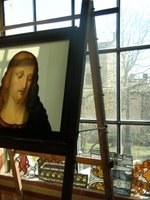 as this tour of the glass studio, to enhance the academic material. Perugia Through the Ages was offered for the first time in Fall 2005 and has quickly become one of the Umbra Institute’s most popular couses.
as this tour of the glass studio, to enhance the academic material. Perugia Through the Ages was offered for the first time in Fall 2005 and has quickly become one of the Umbra Institute’s most popular couses.
In photos: Professor Paola Chiurulla and students examine documents within the Studio Moretti Caselli; scraps of glasswork from past projects decorate the museum and studio.
 This week the Umbra Institute signed an agreement with the prestigious Uguccione Ranieri di Sorbello Foundation. The Foundation, named in memory of Uguccione Ranieri di Sorbello (1906-1969), journalist, writer, and diplomat, was founded in 1994 to exploit the cultural heritage of the Ranieri di Sorbello family through historical and cultural projects and exhibitions.
This week the Umbra Institute signed an agreement with the prestigious Uguccione Ranieri di Sorbello Foundation. The Foundation, named in memory of Uguccione Ranieri di Sorbello (1906-1969), journalist, writer, and diplomat, was founded in 1994 to exploit the cultural heritage of the Ranieri di Sorbello family through historical and cultural projects and exhibitions.
The Foundation has a prestigious library of 20,000 volumes. Among the collection is an extensive antique section with more than 3,000 volumes from the sixteenth and seventeenth centuries. In addition the library has a print collection with over 2,300 examples of all different types and time periods, a porcelain collection from the eighteenth century, and a rare collection of embroidery and lace.
This collaboration will allow the Umbra Institute and the Ranieri Foundation to jointly sponsor cultural activities and academic pursuits in Perugia.
For more information about the Ranieri Foundation, visit the website at www.fondazioneranieri.org.
In photo, Professore Ruggero Ranieri, President of the Ranieri Foundation, and Francesco Gardenghi at the Palazzo Sorbello. (text and photo by Zach Nowak, Student Services Assistant)
We have been following the work of Bree Barton since she arrived in Perugia a few months ago, eager to immerse herself in the local culture. She shared An Adventure Awaits, reflections from her first few days in Italy, on this blog in January. Barton, shown in Venice at right, is sharing this piece she wrote for her Creative Writing course.
“Cheese has never tasted this good. Ever.”

My pen grazes the crisp white page of my journal, filling me with glee. I sit by the Adriatic Sea, the salty air stinging my skin as I brave the January chill. Winter in Naples: certainly warmer than Perugia, but frosty nonetheless. Still, I bartered for my tavolo sul mare, and the breathtaking view of the bay is more than enough to warm the soul.
It’s true; I’ve never had cheese that tasted this good. Mozzarella di bufala, one of the genuinely brilliant Italian products that make any foreigner salivate, is a thing of legend. It’s argued that the cheese originated in a 12th century monastery when Monsignor Alicandri treated hungry visitors to homemade “mozza” on slabs of hearty bread. Today the cheese undergoes similar exercises in tenderness and personal care; much like a baker making bread, the 21st century cheesemaker kneads the mozzarella with his hands until he obtains a smooth, shiny paste. At the prime moment of perfection, he slices off a strand and the individual mozzarella is formed: a succulent, spherical, creamy ball of goodness that’s served in its dazzling nakedness to hungry tourists, poised with fork in hand to gobble it up. With each sliver I cut for myself, my mouth is filled with the sweet taste of shepherds and grass, of buttery cream and the mellow warmth of the cheesemaker’s hands. The plump mozzarella ball serenades my mouth with the rich and robust notes of the Italian south. I savor each bite, letting the cheese ferment against my tongue, my teeth, my palate, flooding my mouth with fertile flavor.
And then there’s the vino, the divine touch of any Italian meal. This wine is unusually delectable, the perfect crimson counterpart to my ivory delight. Eager to eternally preserve the moment, I scribble down the wine’s name in my journal: Lacryme Christi, or Christ’s Tears. The monks of Mt. Vesuvius chose a fittingly religious name for their handiwork, a lush wine made from grapes grown on the fertile volcanic slopes. Perhaps this is why it’s so divine. The taste of the wine is sweet, deep, rich and rosy, with a hint of roasted almonds and mimosa and cinnamon and melted blackberries. It conjures up images of cozy hearths, crackling fires, the subtle melodies of southern dialects, ebony ringlets and smooth olive skin. My mouth tingles with a smoky hue as the taste lingers, the wine flooding my body with fiery warmth. There are echoes here of those two ancient cities, buried nearby under ash and molten lava by the devastating eruption of 79 AD. As I dine under the silent shadow of Mt. Vesuvius nearly two millennia later, I’m sipping the fruits of this monster, a wine from crushed grapes, grapes infused with life from the treacherous volcanic soil, the wine a lovely byproduct of an acknowledged killer. I’m imbibing history, and tragedy, and life, the liquid dripping down my throat like boiling blood, spicy, full, profound. My mind is jolted to life; my pen scratches furiously.
Somehow, this cheese and wine is more than a dinner, more than mere food and drink for me. It’s the union of physical pleasure and soulful revelry, a fusion of history and modernity, death and life. It’s liberating to sit alone, contented, watching the rippling reflections of the bay, the slivers of moonshine on the water, fishing boats strewn amongst the collage of lights. And all the while I stuff my belly and luxuriate in the tastes and smells of freedom, a freedom that comes when dueling forces make peace at last, pausing to kiss with wine-stained lips. Sometimes, at rare moments, the turmoil of life subsides, even if only momentarily, and for once, just once, things make sense.
Life has never tasted this good. Ever.
 The Italians call it “Crazy March” for the unexpected changes in weather which mark the transition from winter to spring. The same can be said about this time at Umbra, when students are busy with their academic work, co-curricular excursions, and their own personal travels.
The Italians call it “Crazy March” for the unexpected changes in weather which mark the transition from winter to spring. The same can be said about this time at Umbra, when students are busy with their academic work, co-curricular excursions, and their own personal travels.
Last weekend, two classes left Perugia for overnight excursions. Students enrolled in Archeology of Italy spent two days exploring ruins in Tarquinia and Cerveteri, ancient towns north of Rome (in photos). Another group of students spent one day in Florence and another in Rome analyzing the art of Michelangelo. Umbra’s academic program includes on-site learning opportunities for several courses. This weekend, students enrolled in the Roman Empire, Perugia through the Ages, and Food Cultures courses will embark on their class trips.
It is also that time of the semester when students flock to the computer labs at Umbra to prepare for midterms. Students have research papers, presentations, and exams on their minds – with the solace that spring break begins next Wednesday.
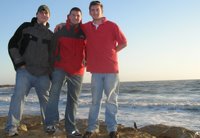
In photos: members of the Archeology class around the ancient burial mounds in Cerveteri; three Elon University students take a break during the Archeology trip for a sunset on the beach near Tarquinia.


